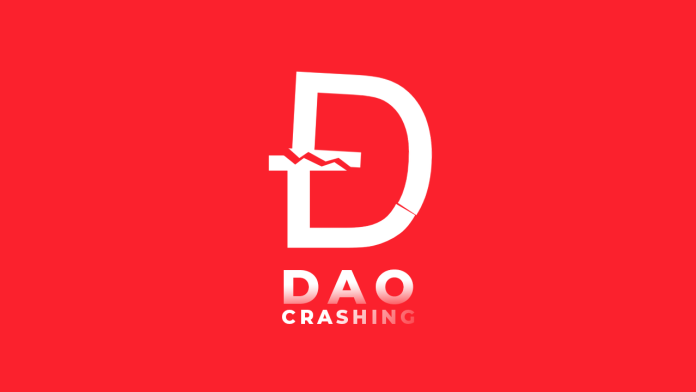In the past months, the DAO market has taken a gigantic dip in crypto prices. Some of the most popular DAOs like Olympus (OHM) and Wonderland (TIME) have decreased over 90% in value in the past 3 months, and many other DAOs are down big as well.
What is the reason for all of this? Why have DAOs lost most of their value in just a short time? Why do some people call DAOs ponzi schemes? And is there hope for a DAO resurgence in the future?
What is a DAO?
In order to understand more about the DAO crash, we must first understand DAOs. A DAO is called a Decentralized Autonomous Organization. DAOs allow holders of the DAO to vote on changes to the DAO’s protocol. Many DAOs, like Olympus DAO, own its own liquidity instead of relying on a 3rd party to provide liquidity.
Olympus DAO, which launched around 10 months ago, was the first DAO to brand itself as a “Decentralized Reserve Currency.” Olympus DAO uses its Decentralized Reserve like a large fund of cryptocurrency assets to back the value of OHM tokens. This value helped create an intrinsic value to use as a guide to help predict the future price. The price of OHM is also backed by $1, and the price of OHM can not fall through that $1 mark, but can still grow as high as it wants. OHM can also issue a bond to investors wanting to buy OHM at a discounted price. For example, if the price of OHM is at $200, OHM can list a bond that is $180, or 10% less than the market value of OHM. Investors can then mint OHM at $180 while the price is still at $200 just by giving Olympus money.
All of these different opportunities in Olympus allowed it to grow its treasury. OHM makes money from investing, fees, bonds, and other sources to build up a massive treasury. Olympus’ treasury currently stands at $530 million (at the time of this writing). Olympus then uses this treasury to pay out a giant APY to anyone who buys and stakes this token through rebases. This APY was the main incentive for anyone who bought OHM. The fact that anyone could buy OHM and stake it to earn over 8,000% per year is what brought so many people into the DAO space.
Why have DAOs crashed?
At the beginning, this revolutionary new model was a success. Olympus became extremely popular. This led to several other crypto projects forking or copying the OHM code and reintroducing it on a new platform or blockchain. Eventually, OHM would become the most forked crypto project ever.
With this newfound way to make money, the DAO market started to get extremely competitive. Everyone was trying to find the highest APY out there. This led to new crypto projects that offered over 100,000% APY, then over 1,000,000% APY just to attract people to stake their cryptocurrency. Some projects even offered a billion percent APY.
This competitiveness led to a DAO market filled with unsafe projects, rugpulls, and frankly just unsustainable APYs that could never be carried out on the long term.
However, people kept coming to the DAO space in hopes of reaping those 100,000% APY rewards. Over time, Olympus fell out of favor with newcomers in the DAO space mainly because their APY (which has been dropping below 8,000% over time) was not as high as other DAOs out there. Also, because they were built on the Ethereum blockchain, which has very high gas fees, it is difficult for smaller investors to put money in the project.
Finally, the nail in the coffin that brought the DAO market down, was leverage. If we switch our view from Olympus DAO to TIME Wonderland, many TIME investors decided that the 80,000% APY wasn’t enough, and they wanted to leverage their holdings of their DAO projects. Many DAO projects, like Wonderland, offered a way to borrow money and use it as leverage. This led to thousands of investors leveraging. In fact, even the founders of some projects, including TIME, leveraged their holdings as well.
So all it would take for a giant crash in the DAO space was for there to be a dip in the market. Once people who were leveraged saw that DAOs across the board started to decline slightly, they began to panic sell. This led to a snowball effect that caused the price of TIME Wonderland, and thousands of other DAOs, to be locked in a bear market. In the case of TIME, thousands of investors got liquidated after the price of TIME dipped below the backing price.
Are DAOs Ponzis?
This giant crash led to a general negative sentiment in the whole DAO space, and people started calling DAOs a ponzi scheme. But, are DAOs really a ponzi scheme? A ponzi scheme, or pyramid scheme, is a way to lure in investors with profits and pay the early investors with the money invested by newer investors. The investors don’t know that the money they receive is coming from other investors, rather they think it is from business activity.
While some people may find the definition of a ponzi scheme similar to a DAO, I don’t think they are the same. True, Olympus does profit from people buying and staking their coin, and they pay out those profits to other investors. However, this only accounts for a small fraction of the amount of money they make. For example, Olympus’ treasury value is over $500 million (as of this writing). Olympus is transparent with what they invest in, and you can see for yourself on their website https://www.olympusdao.finance/ . Olympus, as stated previously, makes money from investing, fees, bonds, stablecoin investments, and many other sources of revenue to build up their treasury. Even with the giant crash, Olympus’ treasury value is only down around 30% from November 1st. If you compare the treasury value drop to the Olympus price drop – $1,000 to under $80 – it is pretty impressive that Olympus has been able to keep their treasury as big as it is. Not only that, but Olympus has been cooperating with other crypto companies and DAOs, and these could eventually turn into partnerships. Olympus is also talking about creating other branches to Olympus DAO, such as an NFT marketplace.
All in all, there is not enough evidence to accuse Olympus of being a ponzi scheme, as it has a constant revenue stream that has been accumulating, and it has been very open and transparent. Many other DAOs that are incorporated with Olympus, such as ROME, have also been active as well. Also remember DAOs are still a new idea, and they still have a long way to go. What are your thoughts on DAOs? You can comment your thoughts in the reply section below this article.





